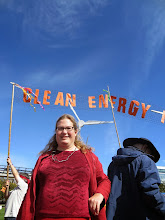The Governor has signed California's long-awaited "solar gardens" legislation into law. Here are some details of the program:
- Utility administered program for Pacific Gas and Electric, San Diego Gas and Electric, and Southern California Edison. It does not affect municipal utilities such as LADWP and SMUD
- 600 megawatts by 2020
- Maximum project size 20 megawatts
- 100 megawatts of projects in identified "environmental justice" communities, maximum 1 megawatt project size
- A directive to market to low income customers (no specific numbers here)
- A directive to locate generation close to load (again, no specific numbers)
- Supports a broad range of eligible renewable technologies - ( a summary can be found at http://www.energy.ca.gov/2010publications/CEC-300-2010-007/CEC-300-2010-007-CMF.PDF )
SGI has received a number of inquiries about whether specific projects or project types would be supported by the law. The law paints with a broad brush, and the California Public Utilities Commission and each utility will decide how to implement their programs. As the process unfolds, we will be working to understand how it will support various models for community projects. You can download the final text of the bill from the SGI website at http://solargardens.org/sb_43_final.pdf
Now we'll never know if "CEC" stands for "Clean Energy Collective" or "California Energy Commission" ...
The law itself is a political compromise. Ambrose Bierce's Devil's Dictionary gives the following definition:
- Compromise n. Such an adjustment of conflicting interests as gives each adversary the satisfaction of thinking he has got what he ought not to have, and is deprived of nothing except what was justly his due.
- We have a California Public Utilities process coming up - so advocates can have some influence in this process to attempt to make sure that community projects can be supported by the various programs.
- The proposed Solar Gardens Institute Charter gives the following definitions of community clean energy (defined here to help guide the upcoming process):
Definition of Community Clean Energy – the scope of our work
A)
Community clean energy is initiated through a
grassroots process with all
stakeholders at the table.
B)
Community clean energy is as distributed as possible - if not on
your roof, in your neighborhood. If not in your neighborhood, within your
county. And if not in your county, in a sister community with a complementary
energy profile (one sunny, the other windy, say).
C)
Community clean energy takes into account all
externalities - carbon footprint,
land use, and visual + auditory impacts.
D)
Community clean energy is integrated into the
local environment with multiple uses
- providing shade, co-located with local food production, or used as public
art. A solar garden should be a place people want to go.
E)
Community clean energy supports local institutions
- agriculture, religious or environmental groups, schools, libraries, community
centers, etc.
F)
Community clean energy is owned in common or fractionally by its
users, or leased-to-own.
G)
Community clean energy keeps money local, re-investing revenue in improvements.
H)
Community clean energy supports local business entrepreneurs, workers, and non-profits.
I)
Community clean energy keeps people engaged in groups, helping them become more
sustainable in every way.
J)
Community clean energy groups work together, share resources and
knowledge, reach out to other communities, and work for further reform
- The charter also includes the Principles of Responsible Solar Development:
a.
Principles
of Responsible Solar Development – How we work with projects
A)
Tree Preservation: By
hosting panels on another rooftop or a community solar garden, people can
protect the trees that shade their houses.
B)
Share the Land with
ecological restoration and agricultural stewardship, using easements.
Plant trees and hedges for visual screening that also take carbon out of the
air. Combine with features like roads, power lines, and snow fences.
C)
Shade Over Pavement instead
of competing with photosynthesis. It’s better to place the solar panels
on shade structures above paved areas such as parking lots and driveways.
New cars can plug in here.
D)
Solar Good Neighbor Policy:
Consider neighbors’ needs in planning installations. Since neighbors
might be installing as well, develop a neighborhood plan.
E)
Limit Facility Scale:
Build to fit within the urban or rural landscape, with most PV facilities less
than 1 Megawatt in size. Use existing distribution lines. The grid
is the tree, and the solar panels are the leaves.
F)
Use Local Designers: Architects,
artists, and even kids can create concepts for installations that reflect local
character.
G)
Smart Microgrids: Renewable
energy and storage can power whole neighborhoods, making them more resilient in
the face of grid disruptions
H)
Responsible Business Practices: Build
using local and recycled materials. Employ local, empowered
worker-owners. Minimize use of toxic materials, use no herbicides, and
maximize energy efficiency.
I)
Local Ownership and Micro-Financing: Everyone
must have the option to own their solar panels. Promote a good price for
selling responsible solar power to the grid, and low interest financing through
public loan guarantees.
J)
A hand up for those who need it: Support a
non-profit that donates panels to low and middle income people, who then pass
on their savings to solarize more homes.
- I hope these help give a working definition of what we mean by "community" renewables (this is, of course, a vigorous matter of discussion all the time).
- Many thanks,
- Joy Hughes
- Founder, Solar Gardens Institute


No comments:
Post a Comment